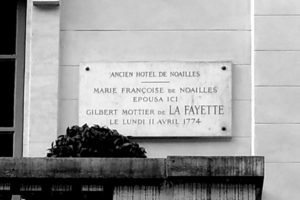
—–
MARIE FRANÇOISE de NOAILLES EPOUSA ICI GILBERT MOTTIER DE LA FAYETTE, le lundi 11 avril 1774
At the back of the block, at 211 ru Saint-Honoré, there are two plaques. The first commemorates Lafayette’s wedding there. The English translation of the plaque would be, roughly:
Ex-Hotel de Noailles
Marie-Françoise de Noailles here married Gilbert Mottier de La Fayette on Monday, April 11th 1774
The lower plaque says:
Histoire de Paris
Hôtel de Noailles
Ici s’élevait un des plus grands et des plus beaux hôtels de Paris, dont les bâtiments et les jardins s’étendaient à l’ouest jusqu’au 229 de la rue Saint-Honoré et au sud jusqu’aux Tuileries. Construit en 1687 par Henri Pussort, conseiller d’Etat, oncle de Colbert, il fut acheté en 1711 par Adrien-Maurice de Noailles, futur maréchal de France et ministre d’Etat. Il lui donna son nom, fit redessiner les jardins par Charpentier et transforma les bâtiments remodelés par Lassurance en un somptueux musée.
Dans la chapelle, une de ses petites-filles épousa La Fayette le 11 avril 1774. Devenu en 1802 la résidence du troisième Consul, Lebrun, l’hôtel de Noailles fut restitué à ses propriétaires en 1814, morcelé et détruit après 1830.
In English, this would be, roughly:
History of Paris
Hotel de Noailles
Here stood one of the largest and most beautiful hotels in Paris, the buildings and gardens of which stretched to the west to 229 rue Saint-Honore and to the south to the Tuileries. Built in 1687 by Henri Pussort, Minister of State, uncle of Colbert, it was bought in 1711 by Adrien-Maurice de Noailles, future Marshal of France and Minister of State. He gave the building his name, had the gardens redesigned by Charpentier, and transformed the buildings remodelled by Lassurance into a sumptuous gallery.
In the chapel, one of his grand-daughters married Lafayette on April 11, 1774. In 1802, it was the residence of the Third Consul, Lebrun. The Hôtel de Noailles was returned to its owners in 1814, and was broken up and destroyed after 1830.